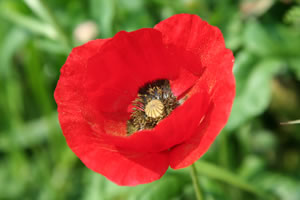August is a good time to plan major garden projects that need pre-winter preparation. A chakra garden is a nice example, and the planning principles are the same for any garden that combines large and small annual and perennial plants.
Cluny Hill, part of the Findhorn Foundation in Scotland, was a Victorian spa hotel and is now used as our community’s main education centre. Our 4½-acre garden is an essential part of the holistic learning environment: a space to unwind and be with Nature. The
10m x 4m chakra garden has seven beds, each representing one of the chakras, the main energy centres of the human body as delineated in ancient Hinduism. It invites deep inner connection and attention to felt qualities in our environment: calm, release, vitality, play, love, transcendence and grace.
Mindful planting
First, contemplate which plants will evoke the qualities of each chakra. You might want to include evergreens to provide a visual frame all year, ground cover, spring bulbs, flowering bushes, early- and late-blooming perennials of different heights (remembering that the foliage of the early-blooming plants will contribute to the late-summer and autumn aspect of the garden), and annuals to be sown or planted. You might consider including edible plants to provide snacks for wandering meditators.
The first chakra (root, red) is primal, related to basic instincts and sexuality. Consider bold shapes like redcurrant, oriental poppy, gladiola, red rose, red tulip, holly, Japanese maple, red dogwood (Cornus alba ‘Sibirica’).
The second chakra (sacral, orange) is related to sensuality, self-esteem and relationships, reflecting the vitality and power of intimacy. This bed is sensual and fragrant. Try lily, tiger lily, orange foliage plants, red hot poker, orange raspberry.
The third chakra (solar plexus, yellow) supports personality, authority, control, humour, joy and quick reactions. Daffodil, columbine, large-flowered tickseed (Coreopsis grandiflora), rose of Sharon (Hypericum calycinum), sunflower and potentilla might be useful.
The fourth chakra (heart, green) should be at the centre, evoking peace, love, forgiveness, harmony and acceptance. Lamb’s ear, lady’s mantle, Pacific bleeding heart, ivy and decorative grasses can contribute to this atmosphere.
The fifth chakra (throat, sky blue) reflects the quality of flowing communication. Try broadleaf forget-me-not, delphinium and blue poppy (Meconopsis). Consider also a small water feature.
The sixth chakra (third eye, indigo) holds intuition, vision and thinking. Delicate scents and complex plant shapes are appropriate. Think of true indigo, low blueberry and English lavender.
The seventh chakra (crown, white) could contain a serene statue as a focal point. The theme is divinity. Delicate forms like baby’s breath, lily of the valley and silver artemisia would be appropriate here.
A few planting tips:
• Once you have ideas for plants, sketch out the beds on paper; the beds might be circular or oval, with a path wending through them.
• Consider the size of the plants when mature.
• Before it gets cold, dig out and nourish the beds with compost.
• Save yourself weeding by establishing mulch and ground cover.
• Contemplate defining a path with bark, gravel, stone or tiles.
• Transplant your own plants when appropriate, and visit your local nursery to find more.
• Plant lots of bulbs in September or October so that your early spring chakra garden will motivate you to keep working!
It takes several years to refine a multi-season display, so take your time and use your chakra garden regularly to restore your patience and connection with self and Nature.







